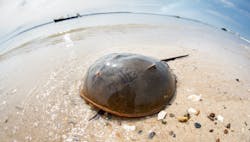In the 1960s, the average person did not give much thought to the comings and goings of horseshoe crabs.
For decades prior, humans had been mindlessly grinding up the 10-legged creatures for use as fertilizer; but even that practice began to subside with the invention of artificial means. Hence the harmless sea dinosaurs were mostly left to go about their happy horseshoe lives, milling around the ocean floor doing all the things that crabs like to do.
But Johns Hopkins professor Fred Bang wanted to study the circulatory system, and because you can observe a horseshoe crab’s transparent circulatory system by simply flipping it over, the ancient, yet unfamiliar creatures became the subject of his studies. Everything was going as planned until an outlier crab gave him pause. One day Bang noticed that one of his arthropodic subjects had seemingly died from an infection that had caused most of the crab’s blood to clot into a semi-solid blob.
Stumped, Bang eventually approached fellow professor Jack Levin, a hematologist who had never seen nor even heard of horseshoe crabs, but who agreed to help. Despite his extensive work with human platelets, Levin couldn’t keep the horseshoe blood he was studying from clotting. Ultimately, he solved the mystery — discovering that the blood coagulation mechanism in horseshoe crabs was extremely sensitive to the presence of a specific type of toxic substance released by bacteria, called endotoxins.
Most in the pharma industry are familiar with the end of this story. The limulus amebocyte lysate test, produced from the blood of harvested horseshoe crabs, became the gold standard for endotoxin detection throughout the world. To date, it remains integral to the safe manufacturing of vaccines, injectable drugs and certain medical devices.
It’s a common theme in medicine, where the study of something small and obscure unlocks broader scientific knowledge.
Today, the average person is unlikely to know much about the 7000+ rare diseases currently identified. But it’s the study of these highly specific disorders that has led to invaluable understandings of many more common diseases.
For example, research into the most rare, severe cases of familial hypercholesterolemia, a hereditary condition characterized by very high levels of cholesterol in the blood, enabled scientists to form a link between cholesterol and heart disease. This ultimately led to the development of statins, now the most commonly prescribed class of cholesterol-lowering drugs.
Researching treatment options for rare diseases has resulted in discovering underlying causes, bringing about life-changing breakthroughs in areas such as cancer, diabetes, obesity and migraines. Put simply, without the study of rare diseases we would have less fundamental understanding of treatments and disease as a whole. Quite often it’s the outliers — the one horseshoe crab that develops a severe reaction to a mysterious infection or the one malfunction of a biological pathway — that ultimately produce greater understanding of normal function.
As you will read in this month's cover story, the pharma industry is diving deeper into the rare disease space. And as they do so, they are entering a world that has transformed the face of pharmaceutical treatment. This leap does not come without a learning curve and an increased responsibility to patients.
With a 450-year lineage, horseshoe crabs are one of nature’s great survivors. They are also an important reminder that something seemingly mall can be powerful enough to create tidal waves of progress.






